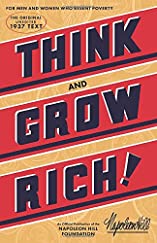
This month’s book was a challenge. Not that there weren’t enough books on the topic, but rather landing on just the right one. After much deliberation, I chose Think and Grow Rich by Napoleon Hill.
Think and Grow Rich
This book was first published in 1937. In my opinion, it is the grand daddy of all business, entrepreneurial, growth mindset and motivational books. From it springs an endless well of thoroughly researched and clearly articulated concepts to help one succeed in life.
The book appeared on my radar a number of times over the years, but I was turned off by its title. It appeared to be another “get rich quick” book. This preconception of mine should have been an important mental trigger for me, but it wasn’t, until now.
What’s Your Money Mindset?
I generally write about financial literacy, budgeting, debt and the stressors associated with money management or rather, the lack of it, during the month of November. It is Financial Literacy month in Canada. While there are a number of helpful resources on managing debt, creating budgets and saving for the future, what’s missing is what’s in Napoleon Hill’s book.
Instead of writing a book summary here, I’m directing you to Paul Minor’s post as it beautifully captures the key concepts in Think and Grow Rich.
For me, this almost 100 year old book was enlightening and relevant. Even though it is written in a more formal style for today’s reader, it was on-point and topical. It helped me get in touch with my own feelings about wealth and abundance — non of which have to do specifically with money.
Here’s what I’ve learned:
- Thinking about money is an emotional experience.
- Our beliefs can stem from programming and views shared with us from influencers (parents, caregivers, teachers) in our childhood.
- Our beliefs about money drive our behaviour.
- Operating from a place of denial won’t help our relationship with money.
Look Inward
Take time — even if it feels scary — to examine your relationship with money. It is the starting point for changing your mindset and having a better relationship with your finances.
The website DollarPlusSense.com gives you a criteria for determining if you have a positive or negative relationship with money.
I invite you to watch Tammy Lally’s 12-minute TED Talk, Let’s get honest about our money problems.
50 Ways to Make Money Exercise
From working with my clients, one of the biggest challenges I’ve observed comes from a lack of seeing the potentiality of abundance. Limiting beliefs and alibis stop people from true transformation and gaining freedom from financial worries.
One exercise I learned and pass along is this:
Create a list of 50 different ways (yes 50!) you can make money right now in your business or personal life.
Give it a Try.
No idea is too far-fetched to capture as long as you don’t comprise yourself or your values. This is a mind-stretching exercise to help you be more creative about finding solutions.
Once you have your list of 50 — and don’t stop until you reach 50 — look at your list and star the best 5. Then come up with a plan in the next 30 to 60 days to take action on the top 2 ideas.
This exercise is simple, but not easy. Stay with it and let it guide your thinking toward a better money mindset. It truly works.




